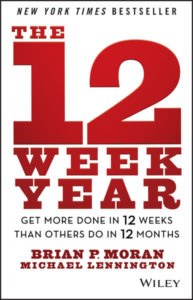The basic idea behind the 12 Week Year is to set quarterly goals instead of annual goals. You’ll need to scale back a little, obviously, but don’t scale back too much. The truth is, we can accomplish a lot in 12 weeks if we’re focused.
Once you have your plan for the quarter, these are your tools to achieve them:
- Weekly plan. A twelve-week period is small enough that you can wrap your head around it without too much difficulty. Every week, decide what you need to do to move forward.
- Weekly accountability meeting. This is like conducting a weekly review with a mastermind group. You’re less likely to slack off when you know you’re going to have to give a report on what you’ve accomplished, even if it’s to supportive peers.
- Track leading indicators. If you want to lose weight, don’t focus on the number of pounds you’ve lost. Instead, focus on the number of calories you consume and the minutes you spend exercising. You can plan for a healthy diet and active lifestyle; the number on the scale follows suit.
- Plan your days in blocks. Strategic blocks are 2–3-hour blocks where you can go deep. Buffer blocks give you margin—time to recover and regroup. Breakout blocks are time spent away from the office, doing something to change up your routine to keep things fresh.
I’ve seen several people disparage this book, saying it was just a 208-page sales pitch for their line of 12 Week Year planning supplies. I didn’t get that sense at all. Moran and Lennington just lay out their approach to time management and teach. Their online store felt like little more than a footnote.


